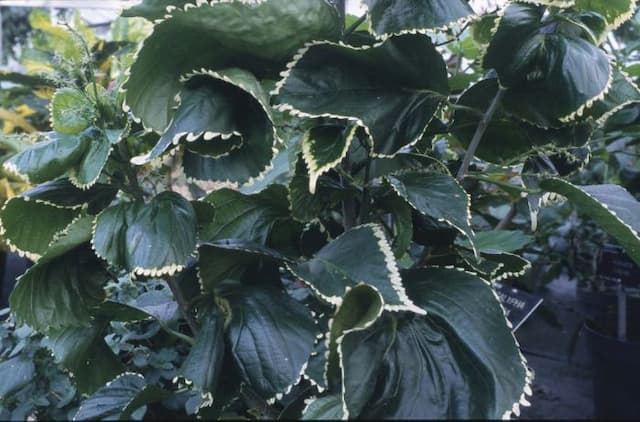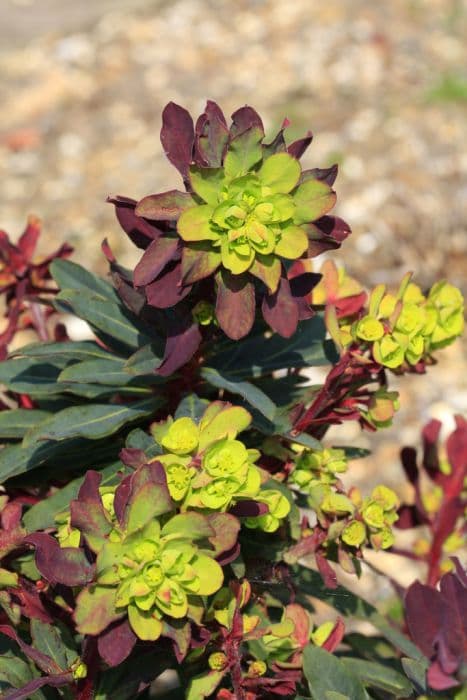Mediterranean Spurge Euphorbia characias subsp. wulfenii

ABOUT
Commonly known as Mediterranean spurge, the plant presents a striking appearance with its dense, bushy clusters of upright evergreen stems. These stems are clothed with narrow, blue-green leaves that are arranged in a spiral fashion, giving the plant a textured and architectural look. During the flowering season, the plant produces rounded clusters of bright yellow-green flowers at the tips of the stems. These flower heads are actually cup-like structures called cyathia, which contain tiny flowers within. The contrast between the vibrant flowers and the blue-green foliage creates a striking visual interest. The overall impression of Mediterranean spurge is one of a sturdy, attractive plant that adds a touch of Mediterranean flair to gardens or landscapes where it is grown.
About this plant
 Names
NamesFamily
Euphorbiaceae
Synonyms
Mediterranean Spurge, Wulfen Spurge, Wulfen's Euphorbia
Common names
Tithymalus characias, Euphorbia veneta, Euphorbia wulfenii.
 Toxicity
ToxicityTo humans
Mediterranean Spurge is toxic to humans. Its milky sap contains compounds that can cause skin and eye irritation upon contact. If ingested, the toxicity can lead to severe gastrointestinal issues such as nausea, vomiting, and diarrhea. In some cases, more serious symptoms could occur, such as difficulty breathing or swallowing, intense burning pain in the throat, and even temporary blindness if the sap comes into contact with the eyes. Handling this plant requires caution, and consumption of any part of the plant should be strictly avoided to prevent poisoning.
To pets
Mediterranean Spurge is also toxic to pets. The plant's sap contains irritants that can cause similar reactions in pets as in humans. If a pet ingests any part of this plant, they could exhibit symptoms including drooling, vomiting, diarrhea, and possibly difficulty breathing if the reaction is severe. The sap can also cause skin and eye irritation. Therefore, it is important to prevent pets from coming into contact with or ingesting any part of the Mediterranean Spurge to avoid poisoning and the associated health risks.
 Characteristics
CharacteristicsLife cycle
Perennials
Foliage type
Evergreen
Color of leaves
Blue-green
Flower color
Yellow-green
Height
4 feet (1.22 meters)
Spread
3 feet (.91 meters)
Plant type
Shrub
Hardiness zones
8
Native area
Mediterranean
Benefits
 General Benefits
General Benefits- Ornamental Value: With its striking blue-green foliage and bright yellow-green flowers, Mediterranean Spurge adds color and texture to garden landscapes.
- Drought Tolerance: As a succulent, this plant is extremely drought-tolerant, making it ideal for xeriscaping or dry garden areas.
- Low Maintenance: Mediterranean Spurge requires minimal care once established, requiring little watering or pruning.
- Pest Resistance: The milky sap that the plant produces is a natural deterrent for many common pests, making it a resilient choice for gardens.
- Long Blooming Period: Mediterranean Spurge has a lengthy flowering season, often from early spring to summer, providing a long-lasting display.
- Deer Resistance: The plant is not favored by deer, making it an excellent choice for areas where deer browsing can be a problem.
- Architectural Structure: Its robust and upright form can add structure to garden designs, especially in contemporary or Mediterranean-style gardens.
 Medical Properties
Medical PropertiesThis plant is not used for medical purposes.
 Air-purifying Qualities
Air-purifying QualitiesThis plant is not specifically known for air purifying qualities.
 Other Uses
Other Uses- Artistic Inspiration: Euphorbia wulfenii's striking architectural form and vibrant green-yellow color make it a favorite subject for garden photographers and painters.
- Garden Borders: Due to its height and structure, it is commonly used to provide an evergreen backdrop or vertical interest within perennial garden borders.
- Xeriscaping: This plant is suitable for low-water-use gardens, due to its drought-tolerant properties.
- Educational Tool: Botany students study Euphorbia wulfenii to learn about plant adaptations in arid environments and euphorbiaceae family characteristics.
- Landscape Contrast: Its bold texture and form offer excellent contrast when paired with fine-leaved grasses or plants within ornamental landscapes.
- Container Gardening: Sometimes used in large pots or containers as a statement piece due to its size and unique floral structures.
- Crafting: Dried stems of Euphorbia wulfenii may be used in floral arrangements or as a part of wreaths and other crafts.
- Seasonal Interest: It provides winter interest in temperate climates, maintaining structural integrity and color when other plants may be dormant.
- Privacy Screening: When planted in groups, its dense foliage can function as a low privacy screen in a garden setting.
- Ecological Support: Though not a primary food source, it can offer shelter and breeding places for insects and small wildlife within a garden ecosystem.
Interesting Facts
 Feng Shui
Feng ShuiThe Mediterranean spurge is not used in Feng Shui practice.
 Zodiac Sign Compitability
Zodiac Sign CompitabilityThe Mediterranean spurge is not used in astrology practice.
 Plant Symbolism
Plant Symbolism- Persistence: Often found in tough, rocky environments, Euphorbia characias subsp. wulfenii symbolizes the ability to thrive in challenging conditions and persist through adversity.
- Protection: The plant's latex sap is toxic and irritant, which lends it the symbolism of warding off negative influences, similar to the protective qualities attributed to its family member, the cactus.
- Adaptability: This Mediterranean native's success in various climates symbolizes adaptability to change and versatility.
- Cautiousness: Due to its toxic sap, the plant is a symbol of caution, reminding one to be careful and aware of potential hidden dangers.
- Healing: While the plant itself is toxic, it belongs to a genus containing species with medicinal properties, symbolizing healing and the dual nature of plants to both harm and heal.
 Water
WaterMediterranean Spurge (Euphorbia characias subsp. wulfenii) should be watered moderately during the growing season, tapering off as the plant enters dormancy in the cooler months. It's important to allow the soil to dry out between waterings, as the plant is drought-tolerant and susceptible to overwatering. Typically, watering once a week during active growth and reducing to once every two to three weeks during dormancy is sufficient. When watering, provide enough water to moisten the soil thoroughly, which might be about 1 gallon for a large plant in a garden setting.
 Light
LightMediterranean Spurge thrives in full sun to partial shade. The best spot for this plant is a location where it can receive at least six hours of direct sunlight each day. If grown indoors, a south-facing window is ideal to provide the bright, indirect light that mimics the natural conditions of its native habitat.
 Temperature
TemperatureMediterranean Spurge prefers a temperate climate and can tolerate a wide range of temperatures. It can survive short periods of cold down to around 20°F but prefers temperatures above freezing. The ideal temperature range for optimal growth is between 50°F and 75°F. Avoid exposure to prolonged temperatures over 85°F, as extreme heat can stress the plant.
 Pruning
PruningPruning Mediterranean Spurge is typically done to remove spent flowers and maintain a tidy appearance. The best time to prune is after blooming, which usually occurs in late spring or early summer. Pruning can also stimulate new growth. Cut back the flower stalks to the base and remove any dead or damaged foliage. Pruning is not required frequently; once a year is usually sufficient.
 Cleaning
CleaningAs needed
 Soil
SoilMediterranean Spurge requires well-drained soil and thrives best in a mix with equal parts of potting soil, coarse sand, and peat or another organic matter. A slightly alkaline to neutral pH of around 7.0 to 7.5 is ideal for this plant.
 Repotting
RepottingMediterranean Spurge does not require frequent repotting and can often be repotted every two to three years. It's best to repot in spring when signs of the plant becoming root-bound are evident.
 Humidity & Misting
Humidity & MistingMediterranean Spurge prefers a dry climate and does not require high humidity levels. It is well-suited to the moderate ambient humidity typically found in most home environments.
 Suitable locations
Suitable locationsIndoor
Provide bright light, avoid overwatering, and ensure proper drainage.
Outdoor
Choose sunny spot, well-draining soil, and shelter from harsh winds.
Hardiness zone
8-10 USDA
 Life cycle
Life cycleMediterranean spurge (Euphorbia characias subsp. wulfenii) begins its life cycle when seeds germinate, typically requiring well-drained soil and full sun. Following germination, seedlings establish themselves with a deep taproot and grow into rosettes of blue-green, oblong leaves. The rosettes evolve into upright, woody-based perennial plants that may reach up to 4 feet tall. In early to mid-spring, Mediterranean spurge produces characteristic inflorescences consisting of cup-shaped bracts surrounding tiny flowers, which are highly attractive to pollinators. After pollination and through summer, the plant sets seed in small, three-lobed capsules that explode when ripe, dispersing seeds into the surrounding environment. The plant is drought-tolerant and may enter a semi-dormant state during hot, dry summers, resuming growth with the onset of cooler, wetter conditions.
 Propogation
PropogationPropogation time
Spring to early summer
Euphorbia characias subsp. wulfenii, commonly known as Mediterranean Spurge, is most commonly propagated by seed. Sowing seeds can be done in late winter to early spring, often in a cold frame or under cover to protect from extreme weather. The seeds should be sprinkled onto the surface of a well-drained seed starting mix and only lightly covered with soil because they require light for germination. Consistent moisture is vital but beware of overwatering as it might cause the seeds to rot. Once seedlings are large enough to handle and after the threat of frost has passed, they can be transplanted into individual pots. It's important to handle the seedlings carefully, as Euphorbia sap can be irritating to skin and eyes.



![Spurge [Blackbird]](/_next/image?url=https%3A%2F%2Fplants-admin.emdemapps.com%2Fimages%2Fplants%2F%2Fimages%2F604b535f37783.png&w=640&q=75)





